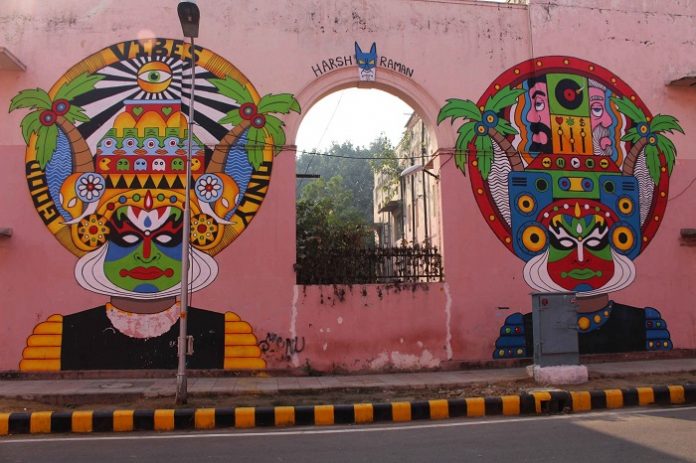A flute seller stands by the roadside selling his ware; a sardarji sits behind a pile of books reading a newspaper; a little distance away a shopkeeper keeps an eye on her spread of sweets even as a cow indolently stares… There seems to be nothing out-of-the-ordinary in this quintessential scene from any Indian town or city.
The only unique aspect being that all the vivid figures are much larger than life and are part of a street mural. It is unbelievable but these gigantic and colorful works of art have completely transformed a quiet residential colony in New Delhi. From being a nondescript neighborhood with uniformly boring buildings, today Lodhi Colony is a buzzing kaleidoscope of a parallel world; a living canvas that brings to life stories from around us and beyond us. The blank walls along the streets have become a canvas for artists from India and across the world, who have turned the area into one of India’s most vibrant public art districts.

The Lodhi residential area in South Delhi was built around the 1940s to house government employees. The complex, the last residential neighborhood built during the British era, reflects neoclassical construction with barrack-like placement of houses, which was a standard feature of colonial-era architecture. Today, after sections of it were painted by artists as part of a public art project, the colony stands transformed. With its walls, lanes and bylanes bursting with eclectic colors, quirky shops and cafés turning themselves into art galleries and a steady trickle of visitors, the neighborhood has shot up the popularity charts and has got itself a new moniker: the Lodhi Art District.
Street art or public art, as it is now popularly known across the world, was born out of a simple idea that art cannot be confined only on canvases for a select group of people. It has now acquired legal and social acceptance and hence differentiated itself from the graffiti-inspired vandalism of the 1960s. It is said that public art adds joy to intense cities, bringing relief in the lives of busy metro residents. At Lodhi Colony, this change is visible all around.
The artworks at Lodhi Colony have not only made the walls of the colony beautiful, they seem to have made the neighborhood cleaner and happier as well. The residents, street vendors, shopkeepers and municipal workers have made community-collective-civic pride one of the major intangible outcomes of the project. Art now permeates the social fabric of the colony. From residents who make sure the exteriors of their homes are well-maintained and children who take pride in preserving the art, to local shop-owners proudly displaying artworks and paintings that were collecting dust in shut cupboards, the entire neighborhood is celebrating art. Even popular café chains have added artistic elements like holographic projections and custom designed souvenir boxes to their previously monotone interiors. The district has brought new respect to street art in the national capital, with mega events like the India Art Fair organising walkthroughs of the area in February and galleries readily representing street artists in their gallery roster.

What started out as a three-wall experiment in 2015 gave shape to the idea. The people behind the project, the NGO St+art (Street+Art) India, realised Lodhi Colony had everything an art district would need: expansive walls, wide streets and an uncluttered layout. In 2016, as part of the Lodhi Art Festival, the art expanded to 25 works and in 2016, the art district took shape. This year, international artists too were invited at the Lodhi Art Festival, to lend their colors to the walls. Today, the area includes works by Indian artists such as Sajid Wajid, Sameer Kulavoor and Hanif Kureshi, and international artists like Daan Botlek from the Netherlands, Singaporean artists Yok and Sheryo, and Japan’s Yoh Nagao, among others. Before the festival opened, questionnaire leaflets were distributed among almost 7,500 households in the neighborhood inviting them to be a part of the festivities. When the festival opened it featured a special ‘Saath Saath’ wall painted by artists and residents in an effort to make art truly democratic and to activate a sense of ownership and community pride.
The founders of St+art, Arjun Bahl, Akshat Nauriyal, Thanish Thomas, Hanif Qureshi and Giulia Ambrogi, want to take art to a wider audience and to make art accessible to all. The organisation aims to bring art out of conventional spaces and make it an integral part of cityscapes. “Art in public spaces empowers people and enables them to think beyond borders. It opens up dialogue between people,” they say.
Upholding the ethos of social and cultural contextual relevance, which means no jarring political or religious imagery, the artworks also reflect realities such as deforestation, climate change and social diversity. Furthermore, St+art’s collaboration with Access for All, an initiative determined to push the boundaries of physical, intellectual and social access in spaces like museums, art galleries and sites of social significance, has led to five walls with tactile elements, and special curated walkthroughs for visually impaired children.
The project is now supported by the European Union. What remains to be seen is the continued impact of public art and the evolution of multi-dimensional collaboration. The Lodhi Art District is no doubt the aggregator that has allowed for this change to take place, and the unfolding of this journey is essential for the public to participate in it.

















